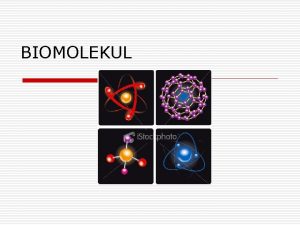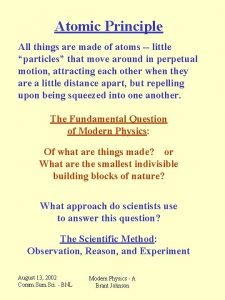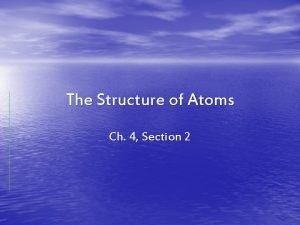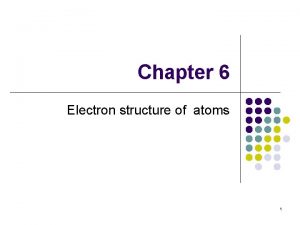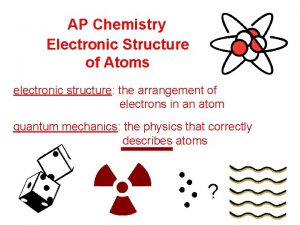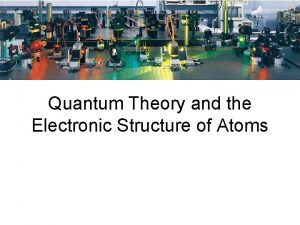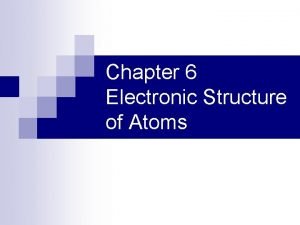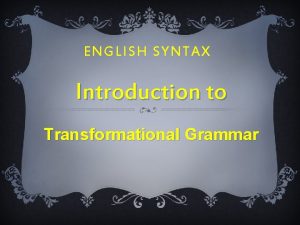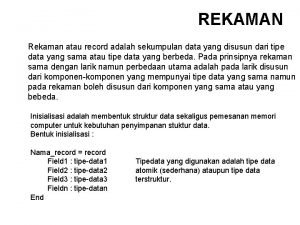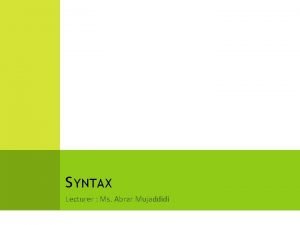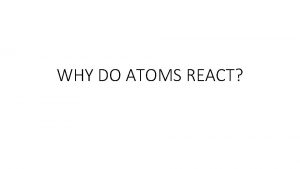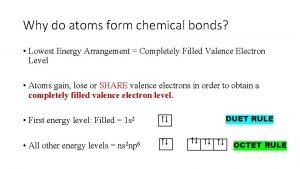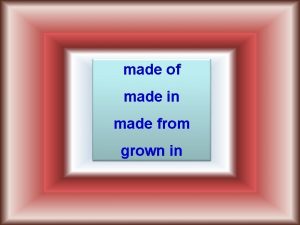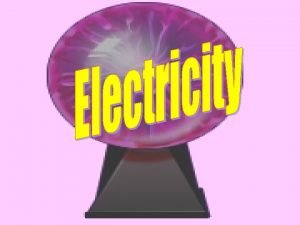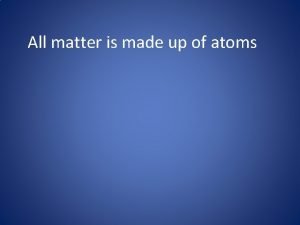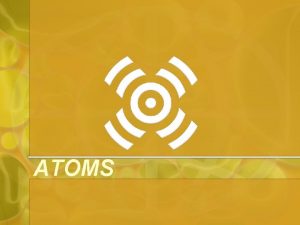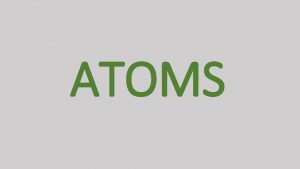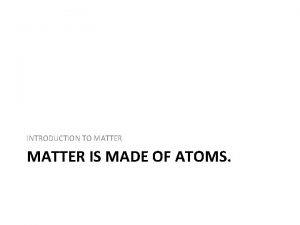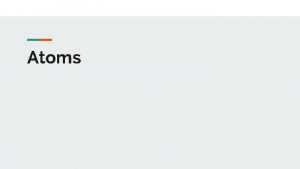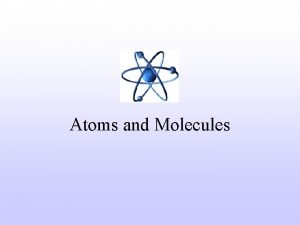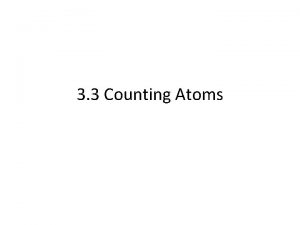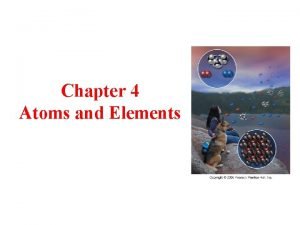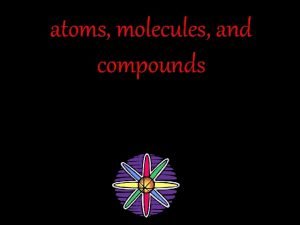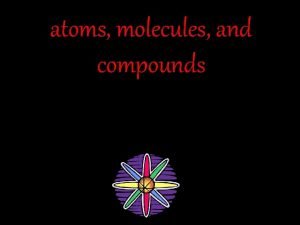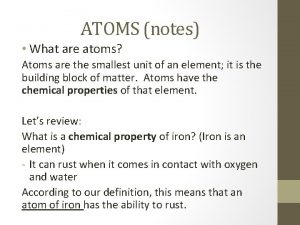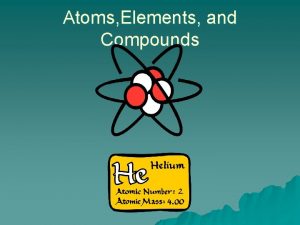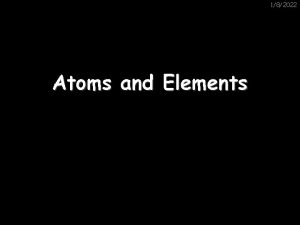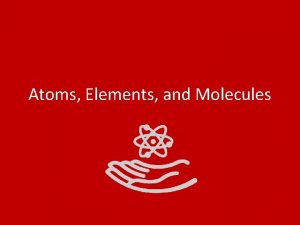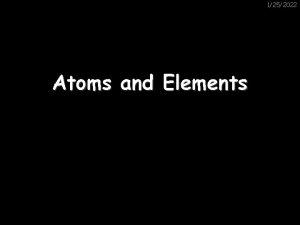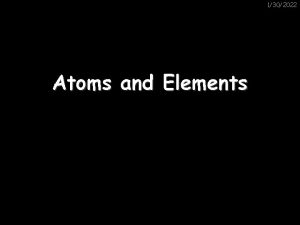Atoms Structure of Atoms Atoms are made up






















- Slides: 22

Atoms

Structure of Atoms § Atoms are made up of subatomic particles:

Structure of Atoms § Atoms are made up of subatomic particles: - Protons; positively charged, and this number is the atomic number.

Structure of Atoms § Atoms are made up of subatomic particles: - Protons; positively charged, and this number is the atomic number. - Neutrons; no charge and described as being neutral.

Structure of Atoms § Atoms are made up of subatomic particles: - Protons; positively charged, and this number is the atomic number. - Neutrons; not charge and described as being neutral. - Electrons; negatively charged.

Structure of Atoms § Atoms are made up of subatomic particles: - Protons; positively charged, and this number is the atomic number. - Neutrons; not charge and described as being neutral. - Electrons; negatively charged. - Protons and neutrons form the nucleus of the atom, with the electrons moving in the space around the nucleus

Structure of Atoms § Atoms are made up of subatomic particles: - Protons; positively charged, and this number is the atomic number. - Neutrons; not charge and described as being neutral. - Electrons; negatively charged. - Protons and neutrons form the nucleus of the atom, with the electrons moving in the space around the nucleus - https: //www. youtube. com/watch? v=l. P 57 g. EWcis. Y

Mass & Atomic numbers § Mass number is the number of protons plus the neutrons in the nucleus.

Mass & Atomic numbers § Mass number is the number of protons plus the neutrons in the nucleus. § Atomic number is the number of protons (and the number of electrons as they are equal).

EG. § Sodium – 11 protons and 12 neutrons. § What’s its atomic and mass number?

Isotopes § Are two or more atoms which have the same number of protons but a different number of neutrons.

Isotopes § Are two or more atoms which have the same number of protons but a different number of neutrons. § The chemical properties of isotopes are the same (however they have a different mass) so it’s impossible to tell the difference in a chemical reaction.

Isotopes § Common isotopes are: - carbon-12 and carbon-14 - Oxygen-16 and oxygen-18

http: //www. youtube. com/watch? v=z. EX 2 a. Gp. IDBY

Electron arrangement on the periodic table

Electron arrangement on the periodic table § Moving across a row of the periodic table, the outer shell increases by one electron, but each element has the same outer electron shell.

Electron arrangement on the periodic table § Moving across a row of the periodic table, the outer shell increases by one electron, but each element has the same outer electron shell. § The last element in each row has a full outer shell

Electron arrangement on the periodic table § Moving across a row of the periodic table, the outer shell increases by one electron, but each element has the same outer electron shell. § The last element in each row has a full outer shell § Elements are stable, or unreactive when their outermost shell is full.

Electron arrangement on the periodic table § Moving across a row of the periodic table, the outer shell increases by one electron, but each element has the same outer electron shell. § The last element in each row has a full outer shell § Elements are stable, or unreactive when their outermost shell is full. EG – Ne: 2, 8 and Ar: 2, 8, 8 are both unreactive because they have full outer shell.

Answer these 1. A carbon atom has 6 protons and 8 neutrons. a) What is the number of electrons in an atom of carbon? b) Write down the atomic number of carbon c) Describe how you know this atom is neutral d) Write the electron arrangement of carbon

Answer these 2. A Mg atom has 12 protons and 12 neutrons. a) What is the number of electrons in Mg? b) Draw a diagram of an Mg atom c) What is the mass number of Mg?

Answer these 3. An atom has atomic number 20 and mass number 42 a) What is the number of protons in the atom? b) What is the number of neutrons in the atom? c) What is the element?
 Antigentest åre
Antigentest åre Periodic table of elements regents
Periodic table of elements regents Bagian terkecil dari polimer
Bagian terkecil dari polimer Are cells made up of atoms
Are cells made up of atoms Nuclear fission
Nuclear fission Chapter 4 section 2 the structure of atoms
Chapter 4 section 2 the structure of atoms Chapter 6 electronic structure of atoms answers
Chapter 6 electronic structure of atoms answers Ap chemistry electronic structure of atoms
Ap chemistry electronic structure of atoms Quantum theory and the electronic structure of atoms
Quantum theory and the electronic structure of atoms Which of the d orbitals most resembles a pz orbital?
Which of the d orbitals most resembles a pz orbital? Key elements of a well-made play
Key elements of a well-made play Covalently bonded substances
Covalently bonded substances N++++
N++++ Giant molecular structure vs simple molecular structure
Giant molecular structure vs simple molecular structure Surface structure and deep structure
Surface structure and deep structure Generative grammar
Generative grammar Np aux vp
Np aux vp Zinc oxide + nitric acid → zinc nitrate + water
Zinc oxide + nitric acid → zinc nitrate + water Queue is a static data structure
Queue is a static data structure Yang merupakan pengertian dari rekaman data adalah ?..
Yang merupakan pengertian dari rekaman data adalah ?.. Deep surface structure
Deep surface structure C3h5 name
C3h5 name What is expanded octet
What is expanded octet


